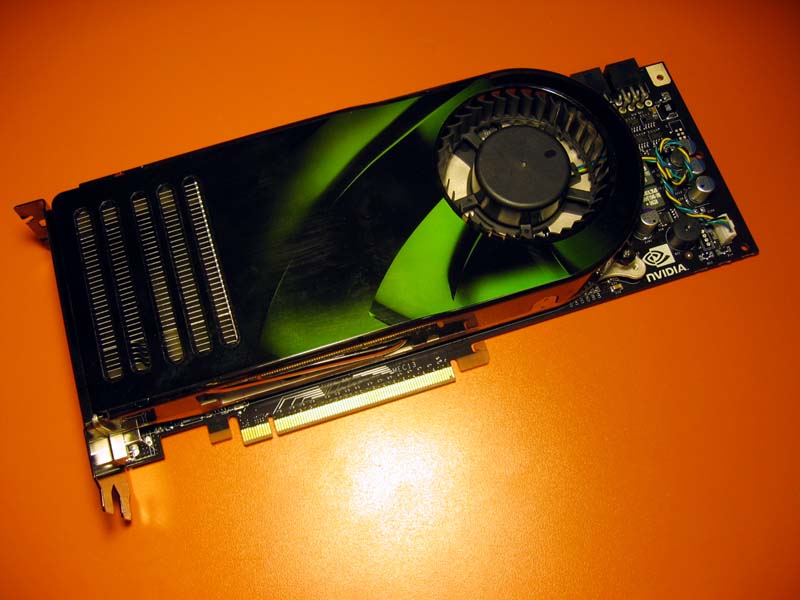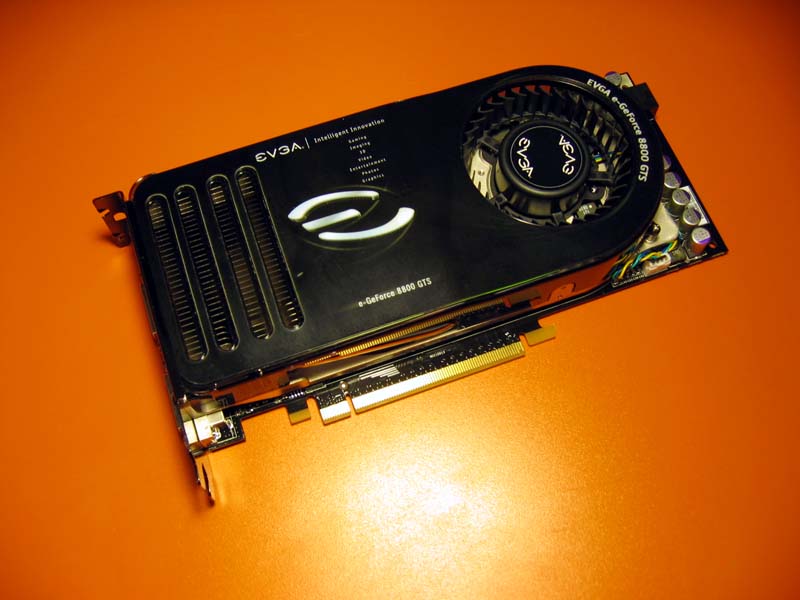By: James Yu - Posted on Wednesday November 8th, 2006
The Windows Vista era won't officially begin until Microsoft finally ships its new operating system next January, but PC game enthusiasts will get next-gen PC graphics performance a few months early because Nvidia is ready to ship its new GeForce 8800 GTX and GTS video cards. The GeForce 8800 series GPUs are designed specifically to support DirectX 10, but the chips also feature a new unified shader architecture that will speed up performance in DirectX 9 games on Windows XP.
Nvidia is only shipping the high-end GeForce 8 GPUs for the holiday season. The GeForce 8800 GTX has a $600 MSRP, and the slightly less-powerful GTS will retail for $450. [Update 11/9/06: Online retailers are currently selling the cards for $50 over MSRP.] Instead of the usual 512MB or 256MB memory sizes, the GTX has 768MB of GDDR3 memory clocked at 900MHz and the GTS has 640MB clocked at 800MHz.
 |  |
Choosing the premium GTX model will get you 128 floating-point processors, compared to 96 processors on the GTS. The GTX processors are also faster, clocked at 1.35GHz, which is 150MHz faster than the GTS's 1.2GHz processors. If those processor speeds seem higher than usual, it's because they are--Nvidia clocked the GeForce 8800's processors independently from the rest of the GPU core for higher performance and to increase performance-per-watt power efficiency. The GeForce 8800 has a record-breaking 681 million transistors, twice as many transistors as the GeForce 7900. Nvidia recommends a 450W power supply for GTX-based cards and 400W for GTS cards. The GTX card also requires two PCIe power connectors.
| GeForce 8800 GTX | GeForce 8800 GTS | |
|---|---|---|
| Price | $600 | $450 |
| DirectX | DirectX 10, SM4 | DirectX 10, SM4 |
| Transistors | 681M | 681M |
| Core speed | 575MHz | 500MHz |
| Stream processors | 128 | 96 |
| Shader speed | 1.35GHz | 1.2GHz |
| Memory | 768MB | 640MB |
| Memory speed | 900MHz (1.8GHz DDR) | 800MHz (1.6GHz DDR) |
| Memory interface | 384-bit | 320-bit |
The GeForce 8800's unified shader architecture doesn't distinguish between pixel and vertex work--it all runs through the same processor pool. If a frame is light on triangles but heavy on pixel shading, a GPU with a unified architecture can balance the workload to make sure all the processors are properly engaged. A traditional GPU might run all of its pixel shaders at full capacity, while half of its vertex shaders sit idle in that same situation.
Rollover image to see comparison between HDR lighting and HDR lighting with antialiasing.
The GeForce 8800 is also ready for Blu-ray and HD DVD high-definition video playback. The chip can support HDCP (provided the board manufacturer adds the encryption ROM), and the GPU's extra computational power has let Nvidia improve image quality for H.264 and VC-1 high-definition video content by enabling spatial-temporal deinterlacing, inverse telecine, noise reduction, and edge enhancement video postprocessing effects.
Nvidia has added new hardware to the GeForce 8800 specifically for nongraphics computation on the GPU. The GeForce 8800 has a dedicated thread-execution manager and shared data cache designed to keep processors well fed and highly efficient. Nvidia has also developed a complete SDK, including math libraries and a C compiler that will make it easier for programmers to access the GPU's hardware. Gaming applications include physics, but Nvidia chief architect David Kirk believes that the thread-computing-enabled GPU will play a more significant role in supercomputing. It'll be "one of the most effective ways to solve large problems because it'll be easier to program than traditional parallel devices," according to Kirk.
What do you think of the GeForce 8800 GTX and GTS? Are you getting one now or will you wait until next year?
System Setup: Intel Core 2 Extreme X6800 @ 3.2GHz, Intel 975XBX (for CrossFire), EVGA nForce 680i SLI, 2GB Corsair XMS Memory (1GB x 2), 160GB Seagate 7200.7 SATA HDD, Windows XP Professional SP2. Graphics Cards: GeForce 8800 GTX 768MB, GeForce 8800 GTS 640MB, GeForce 7900 GTX 512MB, Radeon X1950 XTX 512MB. Graphics Drivers: Nvidia ForceWare 96.94, Nvidia ForceWare 93.71, ATI Catalyst 6.10.
What do you think of the GeForce 8800 GTX and GTS? Are you getting one now or will you wait until next year?
System Setup: Intel Core 2 Extreme X6800 @ 3.2GHz, Intel 975XBX (for CrossFire), EVGA nForce 680i SLI, 2GB Corsair XMS Memory (1GB x 2), 160GB Seagate 7200.7 SATA HDD, Windows XP Professional SP2. Graphics Cards: GeForce 8800 GTX 768MB, GeForce 8800 GTS 640MB, GeForce 7900 GTX 512MB, Radeon X1950 XTX 512MB. Graphics Drivers: Nvidia ForceWare 96.94, Nvidia ForceWare 93.71, ATI Catalyst 6.10.
The GeForce 8800 GTX is the fastest video card we've ever tested. The GeForce 8800 GTX took the top spot in almost all of our tests, including 3DMark06, Company of Heroes, Oblivion, and Need for Speed Carbon. The card's only loss was to SLI and CrossFire in F.E.A.R., but we can't fault the 8800 GTX much for losing to two $1,000 dual-card setups.
The GeForce 8800 GTS also performed well. It pulled away from the pack in Company of Heroes, Oblivion, and Need for Speed Carbon but fell back to the main group when we enabled a few of the more challenging graphics settings. Note that we were finally able to place Nvidia GPUs in the Oblivion test with antialiasing enabled. GeForce 7 series GPUs simply couldn't run games with HDR lighting and antialiasing enabled at the same time.
We haven't tested the GeForce 8800 cards in Windows Vista on DirectX 10-enabled games yet. We can't wait to see how the GeForce 8800 runs DX10 games like Crysis, Alan Wake, Unreal Tournament 2007, and Hellgate: London. If it plays those games as well as it plays DX9 games, the GeForce 8800 will be the card to get this holiday season.
What do you think of the GeForce 8800 GTX and GTS? Are you getting one now or will you wait until next year?